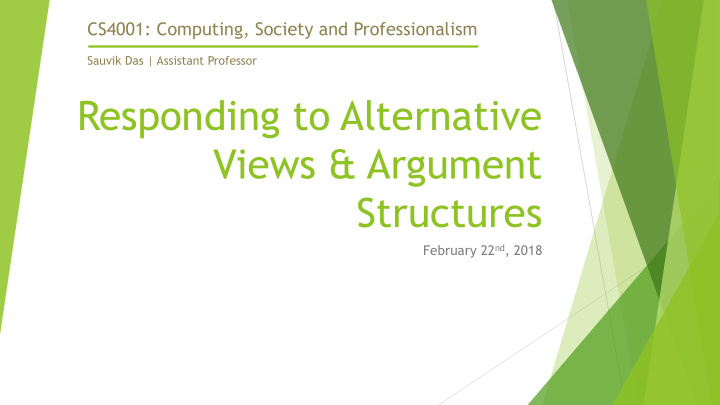



CS4001: Computing, Society and Professionalism Sauvik Das | Assistant Professor Responding to Alternative Views & Argument Structures February 22 nd , 2018
Rhetorical tools u Logos: appeals to logic u Ethos: appeals to authority u Pathos: appeals to emotion u Kairos: timeliness u Pick tools that are most convincing to your target audience
Class Discussion: How to improve ethos in your writing? u Be knowledgeable u Be fair u Build a bridge to your audience u Connect to shared values and assumptions u Demonstrate professionalism u Appropriate style, careful editing, adherence to genre expectations
Class Discussion: How to improve pathos in your writing? u Use concrete language u Use specific examples and illustrations u Use narratives u Choose words, metaphors and analogies with appropriate connotations u Use images
Using pathos u Pathos is legitimate to the extent it deepens understanding of the issue u What are examples? u What are counter-examples?
Ethosappeals to: Intelligence Virtue Morals Perception of trustworthiness Pathosappeals to: Emotions Biases and prejudices Senses Motivations Logos utilizes: Evidence Testimony Statistics and Data Universal truths
Kairos u Timeliness / the right moment u What’s an example?
Class Discussion: Prius Ad
Group Activity u Now that you know the topics for your term paper, with one other classmate, discuss appeals to ethos, pathos, logos and kairos that you might employ in your essay. Then swap.
Customizing to audience enhances rhetorical strength u Who is your audience? u How much does your audience know or care about your issue? u What is your audience’s current attitude towards the issue? u What will be your audience’s likely objections? u What values, beliefs, or assumptions about the world do you and your audience share?
Audience-based reasons u Very common problem in research: failure to understand audience. u Often, you will have multiple audiences
Adversarial vs Dialogic argument u In adversarial, writer presents other side as flawed u Typical argument you see in politics u Dialogic is more neutral – “truth seeking” u Enlists reader as a partner in truth seeking u Encourage sympathy for more than one point of view
Audience-based argument selection u Determine audience’s resistance to your views u If the issue is whether or not to build a new baseball stadium, there might be the following different type of audiences: u No interest in sports u Opposition to public funding of sports u Opposition to raising taxes u Opposition to retractable roof u Hard to address all of these audiences at once.
Classical argument u Appeals to neutral or undecided audience u Summarize opposing views fairly u Principle of charity u Avoid distorting or oversimplifying opposing views u Once you summarize opposing views, either rebut or concede
Rebutting opposing views u Claim: We shouldn’t elect Joe as chairperson u Reason: Because he is bossy u Grounds: Evidence that Joe is bossy u Warrant: Bossy people make bad chairpersons
Rebuttal strategies u Can rebut stated reason and grounds u Joe isn’t really bossy u Can rebut warrant and backing u Bossy people can make great chairpersons
Rebutting evidence u Deny the accuracy of the data u Cite counterexamples or counter-testimony u Doubt the representativeness or sufficiency of the examples u Doubt the relevance or recency of examples, statistics, and testimony u Call into question the credibility of the authority u NOT the same as an ad hominem attack u attack credibility on this issue; not their general character u Question the accuracy or context of quotations u Question how statistical data were produced or interpreted
Conceding opposing views u Concede opposing view, but introduce a new warrant (new value system) u Claim: We should legalize drugs. u Opposing view: We shouldn’t legalize drugs because it will increase the number of addicts. u Concession: Yes, legalizing drugs will probably increase the number of addicts. But, will also help eliminate black market & associated crime
Delayed-thesis argument u Audience: Skeptical with limited knowledge of issue u Complicates the issue (instead of simplifying). Heights reader interest and sympathy. u Intro u Dialogic discussion u Explores issue from multiple points of view u Delayed thesis and support u Conclusion
Rogerian argument u Audience: Interested and resistant u Show that writer and resistant audience share many values u Wait until the end to express a view that is usually a compromise between the writer’s original view and the resistant audience u Especially effective in emotionally laden issues u Must understand audience POV u Stresses self-examination, clarification and accommodation rather than refutation
Rogerian argument structure u Intro u Summary of audience’s views u Common ground u Contribution of new points to the negotiation u Conclusion
Group Activity u Pick an argument structure for your term paper classical vs delayed-thesis or Rogerian. u Explain your paper and why you chose that argument structure to a classmate you don’t already know. Then swap. Discuss!
Recommend
More recommend